Whether you love or hate curries from other countries, you have to try this one at least once. No other curry is quite like the Japanese variation – it’s very thick and umami, and guaranteed to work if you just throw a whole pack of curry roux into the pot.
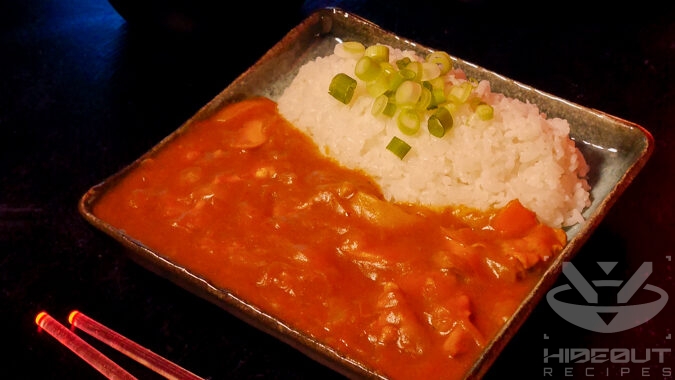
I like my curry just like my women: thick and Japanese.
A Patron
This recipe is very simple, but does take a while to prepare. The good news is that you can make it any amount of hours or even a day in advance, as it only gets better while it rests in the fridge. You can also easily make a large amount and freeze portions for later. Just add a little bit of water when reheating since it tends to thicken over time.
When it comes to cutting the vegetables, especially the carrot and potato, it’s nice to cut them into more complex shapes with a large surface area. There is a special technique I recommend for this purpose called rangiri. As for the ginger and apple, you can use a cheese grater, but I’ve found that a microplane (zester) works best.

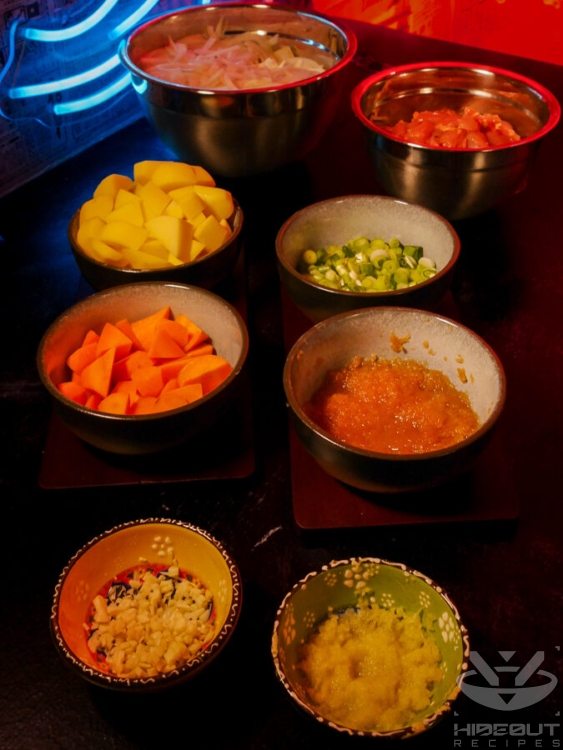
The flavor cube
Whereas with some curries, e.g. from Thailand, making the paste from scratch is a notable upgrade from store-bought paste, I’ve frankly never bothered making my own Japanese curry cubes. That is because none of the ingredients (dry spices, flour, and fat) seem to particularly benefit from being fresh.
You might be wondering if the recipe actually calls for an entire package of curry cubes. The answer is yes – it’s for 8 servings after all. There are different brands of curry to choose from, but I recommend Golden Curry. The medium spiciness (green package) is very mild, but if you’re very sensitive, there is also a completely non-spicy variation. Getting the cubes to dissolve requires some violence, so I recommend doing it in a metal bowl.
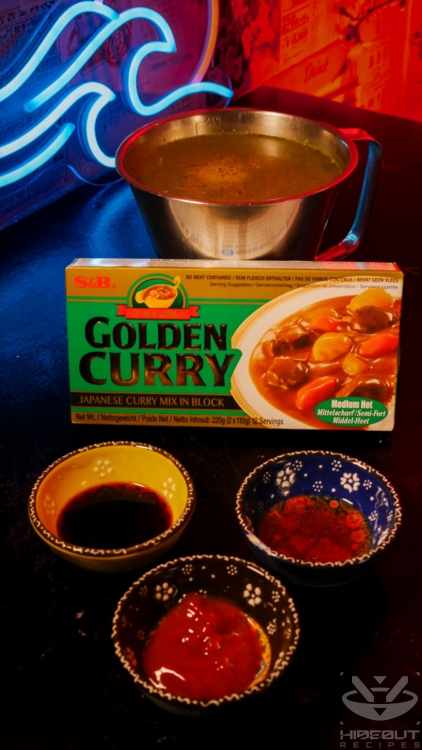
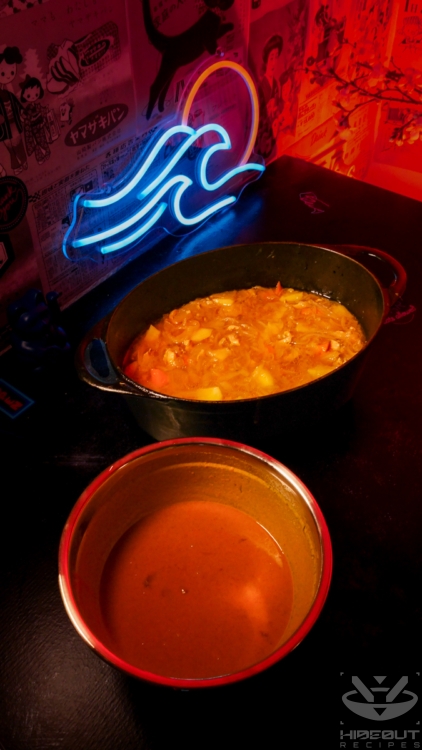
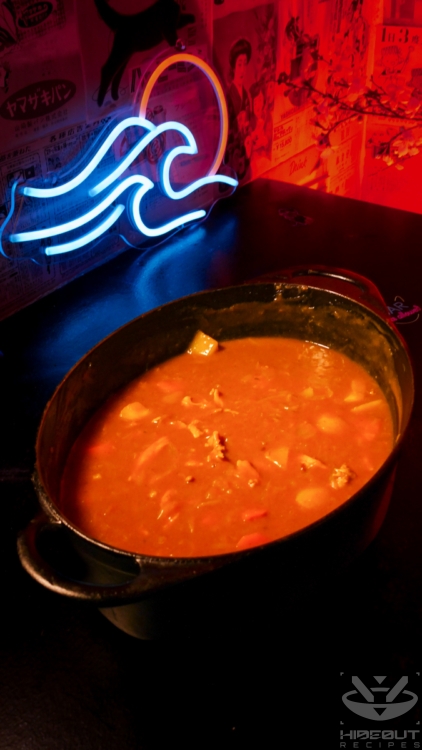
Curry and condiments separate, pre-dissolved, and stirred into the pot
Make it your own
You can of course choose to add or substitute some of these vegetables – or the chicken, in case you prefer beef, seafood, or a vegetarian tofu variation. I personally love Katsu Curry topped with Tonkatsu, but making both is a considerable amount of work. If you do, I recommend making the curry ahead of time and reheating it while frying the cutlets the following day. Of course, the spiciness level can also be adjusted, most easily by picking out the curry cubes you prefer, but you can also add chili flakes or other spicy ingredients while simmering.
Ultimately, just throw in what you like and don’t worry too much about what the “normal” ingredients in Japan are. Whenever I went to CoCo Ichibanya in Japan, the vast customization options were a major selling point, from the rice portion to the spiciness level and, of course, the main ingredients. These included, among others, Tonkatsu, sausages, crab croquettes, spinach, eggplant, squid, and even just grated cheese.
Another way to customize your curry at is by adding condiments at the table. At CoCo Ichbanya, we had Worcestershire Sauce, a spicy spice blend they call “Tobi-Kara”, and pickled vegetables at our disposal. The latter, called Fukujinzuke, add a bit of crunch and can act as a palate cleanser in-between bites. You can buy Fukujinzuke at the store or make your own ahead of time, but none of these condiments are a mandatory addition.
Recipe credit
Like most of my recipes, I started this one out by basing it largely on an existing one, specifically the Japanese Chicken Curry recipe by Just One Cookbook. I’ve since practiced it many times, made changes to the ingredients and steps (sometimes very few, sometimes many), and written up as much additional advice as I could based on my own experience.
Japanese Curry
Equipment
- 1 grater e.g. microplane
- 1 very large pot with lid ideally cast iron
- 1 fine-mesh strainer optional
Ingredients
Curry contents
- 600 g chicken thighs or breast without bone or skin
- 600 g onions white
- 2 carrots
- 3 potatoes waxy, mid-sized
- 2 cloves garlic
- 0.5 apple
- 1 knob ginger thumb-sized
- some black pepper freshly ground
- 2 tbsp neutral oil for frying
For the sauce
- 1 l chicken stock
- 1 tbsp honey
- 1 tbsp soy sauce
- 1 tbsp ketchup
- 1 package Japanese curry roux around 220g
For serving
- 800 g Japanese short-grain rice uncooked amount
Instructions
Prepare the ingredients
- Cut the onions into halves and then into thin slices.Note: If you want to caramelize them slowly, put them in the pot now while cutting the rest.
- Peel both the potatoes and carrots and cut them into bite-sized pieces. If you cut them into irregular shapes, they cook faster and absorb the curry flavor better. Store them in a bowl together.
- Finely chop the garlic or squeeze it through a garlic press.
- Peel and grate the ginger and store it with the garlic.
- Quarter the apple. Remove the core and the skin, then grate it as well.
- Cut the chicken into bite-sized pieces or strips no thicker than 1 cm, then season with the black pepper.
- Finely slice the green onion and set aside for garnish at the end.
- Dissolve the appropriate amount of chicken broth powder in water according to package instructions.
- Mix the honey, soy sauce, and ketchup in a small bowl.
Cook the curry
- Add the oil to a large saucepan over medium heat.
- Add the onions and stir occasionally for at least 15 minutes, or longer to caramelize them. They will decrease in volume considerably and should get slightly browned.
- (If you want to eat rice on the side, now is a good time to get the rice cooker going.)
- Add the minced garlic and grated ginger and stir thoroughly.
- Add the chicken and stir frequently to avoid burning at the bottom of the pot.
- Once the chicken is no longer pink on the outside, add the prepared chicken stock.
- Stir in the grated apple as well as the prepared mix of honey, soy sauce, and ketchup.
- Finally, stir in the carrots and potatoes and put a lid on the pot.
- Turn the heat to medium high to briefly bring to a simmer. Then turn down and let it simmer over low to medium heat for about 15 minutes. Stir occasionally to prevent food from sticking to the bottom.
- Using a fine-mesh strainer, skim off any foam gathering at the surface in this phase.
Dissolve the curry cubes
- Turn off the heat.
- Put 1-2 cubes of the curry roux into a small, sturdy bowl.
- Take a ladle or two of hot broth from the pot and add it to the bowl. Mash the stir with a fork until the cube is fully dissolved.
- Repeat until the full package of curry is dissolved.
- Add the contents of the bowl back to the pot and stir to incorporate.
- Let it simmer for another 5 minutes. The curry should be very thick, but still runny. If it's not the right consistency, keep simmering or add a little bit of water.
- Distribute to bowls or plates along with rice, and sprinkle with green onion slices.
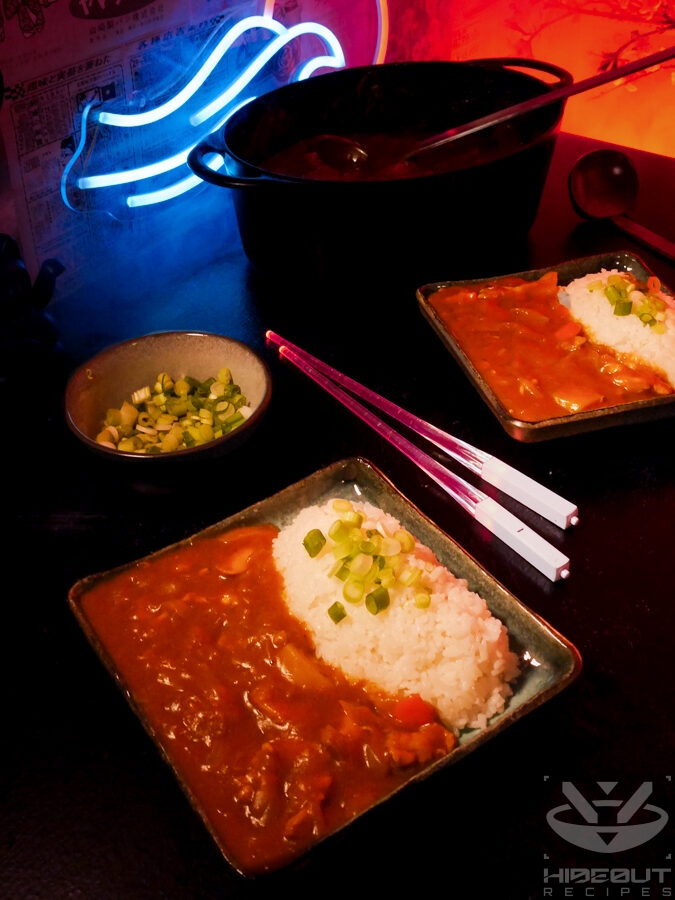



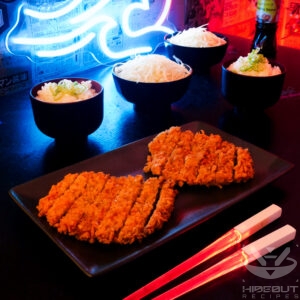
2 Comments
I had to try it. Honestly, I was wary because Japanese curry has a reputation of being too sweet. I used to work at an Indian restaurant, eating channa masala, saag paneer, and plenty others every day of the week.
So I hope you take me at my word when I say that this is a good recipe! A little sweet, yes, but balanced. Maybe use less of the Golden Curry block; that’s my only suggestion. Start with a quarter of the package and gradually add it in, tasting as you go, until you get what you want or use it all.
Hey, thank you so much for trying the recipe and leaving your feedback! A full block of curry does yield a pretty thick and intense result, so adding it gradually to taste makes sense to me. Really glad you enjoyed it!